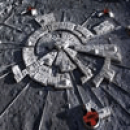Basic concepts
Guides
Basic concepts
Guides
Moons
The Moons are one of the most important elements of AgeOfSpace, not only because they facilitate the fleetsaving of your fleet, but also because they facilitate the hunting of enemy fleets and allow you to move your fleet to another part of the universe in a few seconds. For that reason, it is key to get a moon as soon as possible.
 Unlike the planets, which can be obtained by colonization, the moons are obtained after a battle that has taken place in one of your planets, in which large amounts of debris have been generated; In these situations it can happen that these approach, compact and, with a bit of luck, a moon is created. The moon is created only on the planet where the battle has taken place, and there can only be one moon per planet. The size of this moon is also important, since if it is very small (generated by a small amount of compacted debris) it will be very easy to destroy it.
Unlike the planets, which can be obtained by colonization, the moons are obtained after a battle that has taken place in one of your planets, in which large amounts of debris have been generated; In these situations it can happen that these approach, compact and, with a bit of luck, a moon is created. The moon is created only on the planet where the battle has taken place, and there can only be one moon per planet. The size of this moon is also important, since if it is very small (generated by a small amount of compacted debris) it will be very easy to destroy it.
The probability of getting a moon depends on the amount of debris generated in the battle. It ranges from 1% to 100,000 resources accumulated in the debris, up to a maximum of 20% for 2,000,000 resources (equivalent to the debris generated by the destruction of 2000 Light Hunters). Probabilities ranging from 1 to 19% generate random moon sizes. Only when the probability is 20%, you get the guarantee that the moon will be over 8,366 kilometers in diameter, making it very difficult (and expensive) for other players to destroy it.
Obtain moon
Because a Moon can only be obtained on the planet where a battle has taken place, it is obvious that if you want a Moon, you must be attacked by another player. In the worst case, this situation will be due to not having saved your fleet, or having done a bad fleetsaving, and an enemy destroys the fleet in question (and if you are lucky, you will get the moon as consolation), but It is best to plan the attack with a companion / friend to minimize your losses and optimize your chances of getting a Moon, leaving a number of ships on the planet where you want to have it (for example 2000 Light Hunters). This way, even if you lose those ships during the attack, you will not lose more points than you need to get a 20% chance (and hopefully you can recycle the debris generated and recover some of the losses associated with Luna's attempt).
Another good option, instead of letting you destroy ships, losing points in the process, is to attempt an enemy to launch an attack against you, leaving you a certain number of ships and / or resources as bait, and before your attack reaches your Planet, prepare a trap and destroy all your ships with your own fleet. With a little luck you can get your Moon and also the bonus of the debris generated in the battle to further develop your account.
If you think that all these options are very insecure or complex, you can focus on the so-called “Moon Attempts”, ie; Another player launches a number of ships against the planet where you want to get your moon (usually 2000 light hunters), you destroy them with your fleet, obtaining a 20% probability, and you return the losses caused (or You return to that player the attempt of Moon with other 1667 Light Hunters thrown to one of its planets). In this way you can quickly and easily make several attempts to get your Moon. Of course, you must take into account that all of these options involve a cost, which can be high, since the appearance of a Moon can occur at the first, or may need many attempts (depends entirely on chance and luck You have Remember that in Luna's attempts, you will only have to return the player that makes the losses to you, otherwise you would be in conflict with the Rules of the Game and you could incur Pushing. You can find more details on this last clarification in the Guide of Moonshots and pushing
And,now?
Firstly, it is advisable to move your entire fleet and resources to this new Moon, as you will now be able to perform fleetsavings that are safer and harder to intercept by your enemies. The next step is to expand the functionality of your Moon. The Moon is significantly smaller than a planet, so you should expand the number of available fields first. For this reason, the construction of buildings and facilities on the Moon is different from that explained for a Planet.
First you must build a Lunar Base, which will occupy the only available field on the Moon, but unlock 3 new fields when it is finished. As you develop and expand your Moon you must always keep in mind that the Lunar Base requires a field to be built and unblock new fields where further development of new Facilities. If you occupy all the available fields, you will not be able to extend it further. The 2 useful fields, therefore, that provide you with the construction of a level of Lunar Base, are usually used to develop the Robot Factory and the Phalanx Sensor. Obviously, you must also reserve a field to build the Quantum Leap. On the Moon you can not produce resources, so building a Titanium Warehouse, Graphene or Deuterium Warehouse is meaningless (even if they appear in the list of Possible Buildings).
Hangar is also very useful in the moon if you intend to build ships in it, because due to the scarcity of available fields, you will not develop it to acceptable levels, making it much more profitable and quick to build them on the planet. However, Hangar can be useful if you want to build defenses on your Moon, so that you have greater protection against your enemies. But because of the impossibility of developing the Nanobots Factory on a Moon, trying to build a great defense can mean an important amount of time. The defenses that you build on the Moon can be useful to make it difficult to destroy it by other players or to accumulate a certain amount of deuterium that is useful for the Phalanx Sensor. It is also a good idea to develop the Silo and build Anti-Ballistic Missiles to protect this defense against missile attacks by your potential enemies.
Phalanx sensor
 The Phalanx Sensor is one of the most powerful weapons in the Game. It can not be used to attack enemy fleets or planets, but it can give you valuable information about your enemy's fleet movements, giving you the ability to intercept them, and of course destroy them with your fleet. If you have a Moon with a Phalanx Sensor developed enough, you can get this information with a simple click, from the Galaxy section. The range of your Sensor is calculated by the following formula: ((Phalanx Sensor Level) ² - 1). For example, with a Phalanx Sensor developed at level 3, you will be able to scan all players that are 8 distance systems (in both directions). The scan report using your Phalanx Sensor will appear in a window with a listing of all the fleets of your enemy in flight flying towards those particular coordinates. This way, you can know when you must attack your enemy to destroy the target fleet. The amount of information that a Phalanx Sensor report can offer you depends on your level of Espionage (Level 2: Total number of ships but without determining the type of ship, Level 4: total number of ships and type; Of ships and total quantity of each type). You can find more information on how to use this information in the chapter Blind phalanx guide. It should be noted that every time you scan a player with your Phalanx Sensor, 5,000 units of deuterium are consumed.
The Phalanx Sensor is one of the most powerful weapons in the Game. It can not be used to attack enemy fleets or planets, but it can give you valuable information about your enemy's fleet movements, giving you the ability to intercept them, and of course destroy them with your fleet. If you have a Moon with a Phalanx Sensor developed enough, you can get this information with a simple click, from the Galaxy section. The range of your Sensor is calculated by the following formula: ((Phalanx Sensor Level) ² - 1). For example, with a Phalanx Sensor developed at level 3, you will be able to scan all players that are 8 distance systems (in both directions). The scan report using your Phalanx Sensor will appear in a window with a listing of all the fleets of your enemy in flight flying towards those particular coordinates. This way, you can know when you must attack your enemy to destroy the target fleet. The amount of information that a Phalanx Sensor report can offer you depends on your level of Espionage (Level 2: Total number of ships but without determining the type of ship, Level 4: total number of ships and type; Of ships and total quantity of each type). You can find more information on how to use this information in the chapter Blind phalanx guide. It should be noted that every time you scan a player with your Phalanx Sensor, 5,000 units of deuterium are consumed.
Jump gate
 If you have planets and moon located in different galaxies, you will know that sending your fleet from one place to another can cost you large amounts of deuterium. This problem is not important since the moment you have two moons and build in both the Quantum Leap. Once you get it, you will only have to click on the Facilities section, located on the Moon of departure, select the ships that you want to move towards the objective Moon, click on the jump button and your ships will arrive healthy and saved to the marked Moon . This way you can safely save your ships, making it harder for you to attack and destroy all your progress.
If you have planets and moon located in different galaxies, you will know that sending your fleet from one place to another can cost you large amounts of deuterium. This problem is not important since the moment you have two moons and build in both the Quantum Leap. Once you get it, you will only have to click on the Facilities section, located on the Moon of departure, select the ships that you want to move towards the objective Moon, click on the jump button and your ships will arrive healthy and saved to the marked Moon . This way you can safely save your ships, making it harder for you to attack and destroy all your progress.
But that's not the only reason the Quantum Leap is useful. You can also use it to move your fleet to other areas and to attack new targets in other parts of the universe, to prepare traps for players that attack you and to plan prints, etc.
Of course, be very careful; Remember that you can not send resources through the Quantum Leap. Make sure you have deuterium on the target Moon so you can move the sent fleet there; Otherwise you would not be able to move it and would be easy prey for your enemies, since, after performing a Quantum Leap, the two installations of the two Moons involved remain inoperative during the one hour period. Developing the Quantum Leap above level 1 is a waste of resources (it will bring you more points, but no extra advantage in the Game).